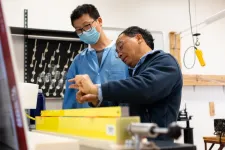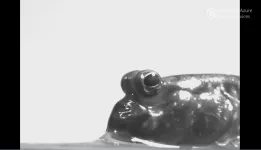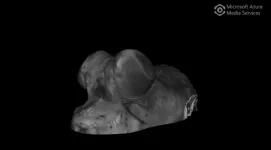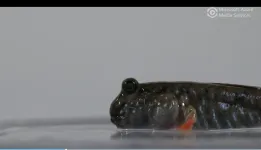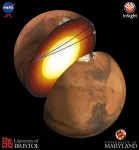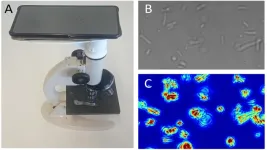(Press-News.org) The promise of superconductivity for electrical power transmission and transportation has long been held back by high costs. Now researchers from the University of Houston and Germany have demonstrated a way to cut the cost and upend both the transit and energy transport sectors by using superconductors to move people, cargo and energy along existing highway infrastructure.
The combined system would not only lower the cost of operating each system but would also provide a way to store and transport liquified hydrogen, an important future source of clean energy. The liquified hydrogen would be used to cool the superconductor guideway as it is stored and transported, reducing the need for a separate specialized pipeline system capable of cooling the fuel to 20 degrees Kelvin, or minus 424 Fahrenheit.
The concept, described in a paper published on April 24, 2023 in the journal APL Energy, suggests a future in which air travel and traditional freight transport could become obsolete, replaced by a “super system” allowing personal and commercial vehicles to travel at speeds up to 400 miles an hour – maybe even twice that fast.
“I call it a world-changing technology,” said Zhifeng Ren, director of the Texas Center for Superconductivity at UH, who came up with the concept and is a corresponding author on the paper. “Superconductivity has had such promise to transmit electric power without power loss, to power magnetically levitating, super-fast trains and for energy storage. But it has not been economically viable, which is why it hasn’t happened at large scale yet.”
The modern era of superconductivity research began in 1987, when a team led by UH physicist Paul Chu discovered a compound which acted as a superconductor at a temperature above the boiling point of liquid nitrogen. Since then, demonstration projects have proven that superconductors can be used to power magnetically levitated trains and to transmit electrical power without energy loss, reducing waste.
Technical details remain to be resolved, said Ren, who is also M.D. Anderson Chair Professor of Physics. “But the learning curve should not be steep since we have learned a lot during the past 40 years or so.”
Financing will be another challenge. And while this proof-of-concept paper does not include an economic analysis, he said combining transit and energy systems and using existing roadways would lower the cost substantially compared to that of any individual system. That, along with the project’s potential long-term economic and environmental benefits, would outweigh the upfront costs, he said.
Magnetically levitating trains traditionally operate on a magnetized rail, with superconductors embedded in the train undercarriage. This concept flips that, embedding superconductors into the existing highway infrastructure and adding magnets to the undercarriages of vehicles, which avoids having to cool the superconductors on each vehicle. Instead, the liquified hydrogen would cool the superconductors as it moves across the system, with liquified nitrogen and a vacuum layer used to thermally insulate the liquified hydrogen.
Researchers built a model to demonstrate the key technical aspect of the concept – levitating a magnet above a superconductor guideway. Liquified nitrogen was used to cool the superconductors in the model; Ren said future models will use hydrogen.
Vehicles with magnetized undercarriages – trains, cargo trucks, even personal vehicles – would enter the superconductor guideway, levitating and moving at high speed to reach their destinations. After leaving the guideway, vehicles would continue their trips powered by traditional electric or internal combustion motors.
People would be able to travel at their own convenience while enjoying the time-saving benefits of high-speed trains and air travel, Ren said. “Instead of 75 mph, you could go 400 mph, from Houston to Los Angeles, or Houston to New York in just a few hours.”
Fuel or electrical power consumption would drop dramatically while the car or truck was on the superconductor guideway, reducing both the cost and the environmental footprint, he said.
“All those benefits together, I think it could change the world.”
In addition to Ren, co-authors on the project include Shaowei Song with the Texas Center for Superconductivity at UH; Kornelius Nielsch with the Leibniz Institute for Solid State and Materials Research in Dresden, Germany; and O. Vakaliuk, U. Floegel-Delor and F. Werfel, all with Adelwitz Technologiezentrum GmbH (ATZ) in Torgau, Germany, which specializes in high-temperature superconductivity material fabrication.
END
Using superconductors to move people, cargo and energy through one combined system
New concept would offer economic, environmental benefits for next-generation transit, energy transmission and storage
2023-04-24
ELSE PRESS RELEASES FROM THIS DATE:
Brian Clark selected to speak, presented discoveries at NIH workshop and in Journal of Gerontology
2023-04-24
Ohio University Professor of Physiology and Executive Director of the Ohio Musculoskeletal and Neurological Institute (OMNI) Brian Clark Ph.D. was one of 40 expert leaders in the field of aging from around the world chosen to present at a workshop hosted by the National Institute of Health’s (NIH) National Institute on Aging (NIA) on the development of function promoting therapies for age-related weakness. Clark was also asked by the NIH to publish a comprehensive review of his research over the past decade in the Journal of Gerontology.
The workshop covered ...
Increased risk of Alzheimer's disease due to exposure to polycyclic aromatic hydrocarbons
2023-04-24
Polycyclic aromatic hydrocarbons (PAHs) are typical organic compounds found in cigarette smoke and vehicle exhaust. In addition, PAHs are produced from incomplete combustion of organic material and cooking. The highest concentrations of PM-bound PAHs ranged from 550 ng/m3 to 39000 ng/m3, were observed in Chinese kitchens, fire stations, and ships. Polycyclic aromatic hydrocarbons may combine with ultrafine particles (UFPs) in the air to form particle-bound PAHs. PM0.1 may adsorb large amounts of toxic organic compounds, and long-term exposure to indoor UFPs from cooking resulted in ...
This gel stops brain tumors in mice. Could it offer hope for humans?
2023-04-24
Medication delivered by a novel gel cured 100% of mice with an aggressive brain cancer, a striking result that offers new hope for patients diagnosed with glioblastoma, one of the deadliest and most common brain tumors in humans.
“Despite recent technological advancements, there is a dire need for new treatment strategies,” said Honggang Cui, a Johns Hopkins University chemical and biomolecular engineer who led the research. “We think this hydrogel will be the future and will supplement current treatments for brain cancer.”
Cui’s team combined an anticancer drug and ...
New tools capture economic benefit of restoring urban streams
2023-04-24
An interdisciplinary team of researchers has developed a suite of tools to estimate the total economic value of improving water quality in urban streams. The work can assist federal and state agencies charged with developing environmental regulations affecting urban ecosystems across the Piedmont Region of the United States, which stretches from Maryland to Alabama.
“Urban streams are ubiquitous and face a number of stressors from rapid economic development,” says Roger von Haefen, professor of agricultural and resource economics at North Carolina State University and corresponding ...
A blinking fish reveals clues as to how our ancestors evolved from water to land
2023-04-24
UNIVERSITY PARK, Pa. — An unusual blinking fish, the mudskipper, spends much of the day out of the water and is providing clues as to how and why blinking might have evolved during the transition to life on land in our own ancestors. New research shows that these amphibious fish have evolved a blinking behavior that serves many of the same purposes of our blinking. The results suggest that blinking may be among the suite of traits that evolved to allow the transition to life on land in tetrapods — the group of animals that includes mammals, birds, reptiles and amphibians — some 375 million years ago.
The study appears the week ...
New machine-learning method predicts body clock timing to improve sleep and health decisions
2023-04-24
A new machine-learning method could help us gauge the time of our internal body clock, helping us all make better health decisions, including when and how long to sleep.
The research, which has been conducted by the University of Surrey and the University of Groningen, used a machine learning programme to analyse metabolites in blood to predict the time of our internal circadian timing system.
To date the standard method to determine the timing of the circadian system is to measure the timing of our ...
Health surveys, studies exclude trans people and gender-diverse communities, impacting health care
2023-04-24
ANN ARBOR—Health surveys and clinical studies have a data collection problem: Because of the way they record sex or gender, they often exclude transgender and gender-diverse people, according to University of Michigan research.
Most studies and surveys either ask participants for their sex, a biological construct, or their gender, a social construct. In this way, they only consider either sex or gender independently or use the two concepts interchangeably, says Kate Duchowny, a research assistant professor in the Survey Research Center at the U-M Institute for Social Research.
Participants either respond with their sex assigned at birth or the ...
Scientists detect seismic waves traveling through Martian core for the first time
2023-04-24
Scientists observed seismic waves traveling through Mars’ core for the first time and confirmed model predictions of the core’s composition.
An international research team—which included University of Maryland seismologists—used seismic data acquired by the NASA InSight lander to directly measure properties of Mars’s core, finding a completely liquid iron-alloy core with high percentages of sulfur and oxygen. Published in the Proceedings of the National Academy of Sciences on April 24, 2023, these findings reveal new insights into how Mars formed and geological differences ...
Pioneering research sheds new light on the origins and composition of planet Mars
2023-04-24
A new study has uncovered intriguing insights into the liquid core at the centre of Mars, furthering understanding of the planet’s formation and evolution.
The research, led by the University of Bristol and published in the journal Proceedings of the National Academy of Sciences of the US, reveals the first-ever detections of sound waves travelling into the Martian core. Measurements from this acoustic energy, called seismic waves, indicate its liquid core is slightly denser and smaller than previously thought, and comprises a mixture of iron and numerous other elements.
The ...
Testing antibiotic resistance with a fast, cheap, and easy method
2023-04-24
“We have developed a technique in our laboratories that allows us to obtain an antibiogram within 2-4 hours – instead of the current 24 hours for the most common germs and one month for tuberculosis,” says Dr Sandor Kasas at EPFL. Professor Ronnie Willaert at Vrije Universiteit Brussel adds: “Our technique is not only faster but also simpler and much cheaper than all those existing now.”
Antibiotic resistance happens when bacteria develop the ability to defeat the drugs designed to kill them. It ...
LAST 30 PRESS RELEASES:
Common brain parasite can infect your immune cells. Here's why that's probably OK
International experts connect infections and aging through cellular senescence
An AI–DFT integrated framework accelerates materials discovery and design
Twist to reshape, shift to transform: Bilayer structure enables multifunctional imaging
CUNY Graduate Center and its academic partners awarded more than $1M by Google.org to advance statewide AI education through the Empire AI consortium
Mount Sinai Health system receives $8.5 million NIH grant renewal to advance research on long-term outcomes in children with congenital heart disease
Researchers develop treatment for advanced prostate cancer that could eliminate severe side effects
Keck Medicine of USC names Christian Pass chief financial officer
Inflatable fabric robotic arm picks apples
MD Anderson and SOPHiA GENETICS announce strategic collaboration to accelerate AI-driven precision oncology
Oil residues can travel over 5,000 miles on ocean debris, study finds
Korea University researchers discover that cholesterol-lowering drug can overcome chemotherapy resistance in triple-negative breast cancer
Ushikuvirus: A newly discovered giant virus may offer clues to the origin of life
Boosting the cell’s own cleanup
Movement matters: Light activity led to better survival in diabetes, heart, kidney disease
Method developed to identify best treatment combinations for glioblastoma based on unique cellular targets
Self-guided behavioral app helps children with epilepsy sleep earlier
Higher consumption of food preservatives is associated with an increased risk of type 2 diabetes
NTU Singapore-led team captures first-ever ‘twitch’ of the eye’s night-vision cells as they detect light, paving the way for earlier detection of blindness-causing diseases
Global aviation emissions could be halved through maximising efficiency gains, new study shows
Fewer layovers, better-connected airports, more firm growth
Exposure to natural light improves metabolic health
As we age, immune cells protect the spinal cord
New expert guidance urges caution before surgery for patients with treatment-resistant constipation
Solar hydrogen can now be produced efficiently without the scarce metal platinum
Sleeping in on weekends may help boost teens’ mental health
Study: Teens use cellphones for an hour a day at school
After more than two years of war, Palestinian children are hungry, denied education and “like the living dead”
The untold story of life with Prader-Willi syndrome - according to the siblings who live it
How the parasite that ‘gave up sex’ found more hosts – and why its victory won’t last
[Press-News.org] Using superconductors to move people, cargo and energy through one combined systemNew concept would offer economic, environmental benefits for next-generation transit, energy transmission and storage
